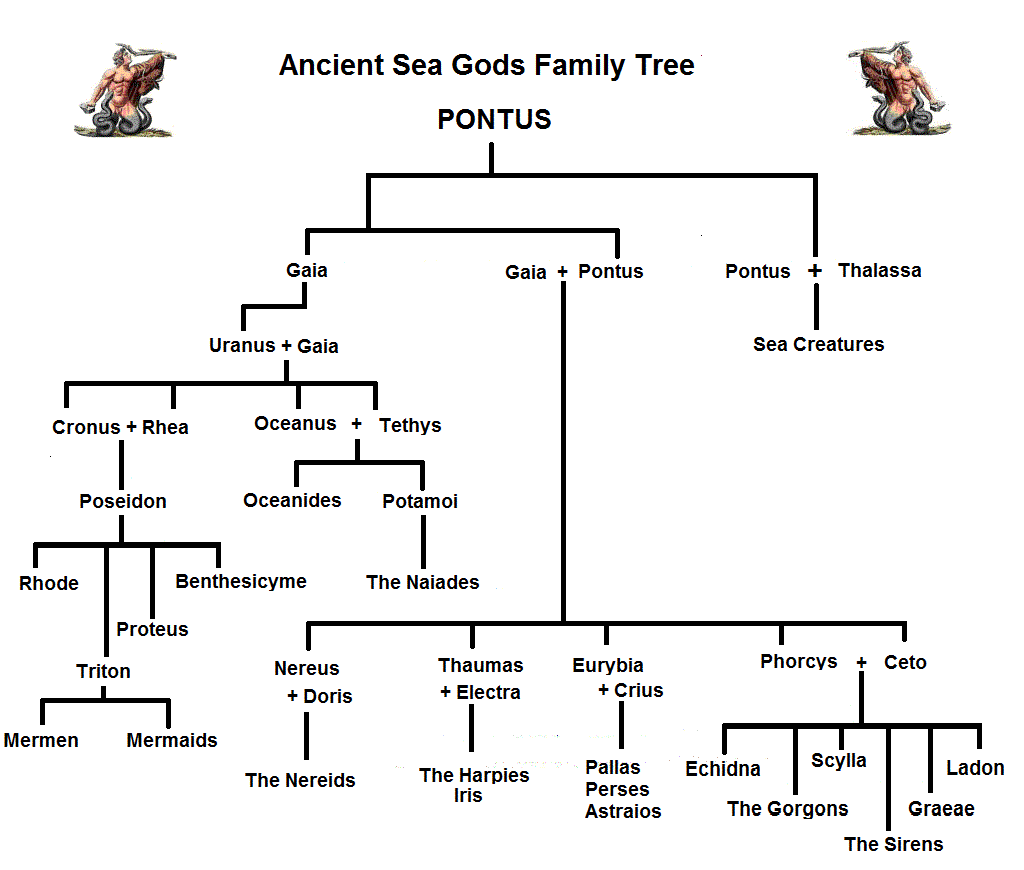The Sea God in Ancient Mythology The Greek Sea God
According to ancient Greek mythology a Sea God featured in every major dynasty of gods - The First dynasty of Ancient Greek Gods were the Primeval or Primordial deities
- The Second dynasty were the Titans
- The Third dynasty were the famous Olympian gods
The names of each Sea God from all of the dynasties are detailed in this article. 
Picture of Poseidon, the most famous Sea God The Sea God Family Tree and Genealogy
According to Ancient Greek mythology the very first sea god was a primeval deity called Pontus. All of the gods of the oceans were descended from his line. The Titan sea god was called Oceanus. The most famous sea god of all was the Olympian god Poseidon (his Roman counterpart was Neptune. The following family tree provides an instant overview of the different generations of Ocean gods. 
Sea God Names, Roles and Descriptions
The roles and the names of the different generations of Sea God who feature in Ancient Greek mythology. The following chart details the sea god names, roles and descriptions, together with facts about sea creatures and sea monsters. The chart provides a list detailing fascinating additional info to increase your knowledge about the Goddesses and Gods of the Ocean who featured in Greek Mythology and legend. Ancient Greek Sea God Names and Descriptions Sea God Names: Sea God Roles and Descriptions Pontus: Pontus was the first great god of the sea and was the consort of his sister Gaia, the Earth Mother. The children of Pontus and Gaia were the sea-deities Nereus, Thaumas, Phorcys, Ceto, and Eurybia. Pontus created all the creatures and spirits of the sea and every sea god was descended from his line. Like many deities associated with the ocean he is often depicted with a pair of lobster-claw horns that adorned his head.
Poseidon: The sea god Poseidon was name of the Greek god of the seas.
Neptune: The sea god Neptune was the Roman counterpart of Poseidon
Thaumas: The sea god Thaumas was the son of Gaia and Pontus. He married an Oceanid called Electra, whose union produced the monstrous Harpies. Thaumas personified the wonders of the sea. His name was derived from the Greek word 'thaumatos' meaning "miracle" or "wonder."
The Harpies: The Harpies were the daughters of the sea god Thaumas and the Oceanid Electra. The Harpies, whose names were Aello, Ocypete, and Celaeno, were vicious winged monster and the personifications of sudden tempests. They had the faces and bodies of women and the wings and claws of birds.
Eurybia: Eurybia was a primeval sea goddess and the daughter of Gaia and Pontus. She became the consort to the Titan Crius and gave birth to Astraeus, Perses, and Pallas
Phorcys: Phorcys was the son of Pontus and Gaia and the sea god of the hidden dangers of the deep. He was consort to his sister Ceto, the primordial sea goddess and their union produced terrible monsters (Echina, Scylla, Ladon, the Sirens, the Gorgons and the Graea)
Ceto: Ceto was the primordial sea goddess daughter of Pontus and Gaia. Her consort was Phorcys and their union produced terrible monsters (Echina, Scylla, Sirens, Ladon, the Gorgons and the Graea)
The Gorgons: The Gorgons were the daughters of Phorcys and Ceto. The petrifying gaze of the Gorgons (Euryale, Stheno and Medusa) were believed to have created the reefs and rocks of the sea. The gorgons, in particular Medusa, featured in the mythology of and legend of the hero Perseus.
Echidna: Echidna was a daughter of Phorcys and Ceto. Echidna was a monstrous sea dragon, half woman half snake (the mother by Typhon of many monstrous offspring)
Scylla: Echidna was another daughter of Phorcys and Ceto. Scylla was a terrifying she-monster who devoured passing sailors
Ladon: Ladon was the hundred headed sea serpent, the off-spring of Phorcys and Ceto, that guarded the golden apples in the garden of of the Hesperides
Oceanus: Oceanus was the lord of the ocean and a principle god in the first dynasty of Titans. He was the son of the primordial gods Uranus and Gaia. His consort was his sister Tethys. Their children were the Oceanides (3000 daughters) and the Potamoi, the river gods (3000 sons). In later myths, Oceanus was replaced by Poseidon.
The Oceanides: The Oceanides were minor goddesses and water nymphs, the 3000 daughters of the Titan gods Oceanus and Tethys. 
Picture of the Oceanides The Potamoi: The Potamoi were river gods and the 3000 sons of the Titans Oceanus and Tethys. They were the brothers of the Oceanides. Sea God Names: Sea God Roles and Descriptions |